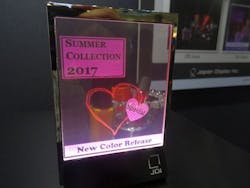Japan Display reveals details on its transparent liquid-crystal display
(Image: Tech-On!)
As noted by Tech-On!, Japan Display Inc. (JDI; Tokyo, Japan), which unveiled a see-through display in January of 2017, has now disclosed specs and a few details of how the transparent display works,
The details were announced at the Society for Information Display 2017 (SID 2017), an academic conference that took place from May 21 to 26, 2017, in Los Angeles, the US (thesis number: 79.4).
The see-through display is a transparent panel when the display unit is off; when it is on, an image is shown on the panel, which still remains transparent. It has a light transmittance of 80%, which is more than 50% higher than that of JDI's previous see-through display. As a result, the background can be clearly seen through the panel.
For this display, JDI developed a new panel-lighting structure and technique. First, to realize a see-through LCD display as thin as a glass plate, the company used a structure in which LED light comes in from the lateral sides of the liquid-crystal cells, rather than the previous backlight structure. The LED light propagates while being totally internally reflected by the liquid-crystal cell front and back walls. At this point, when the LCD panel is seen from above, it looks transparent.
When an electric field is applied to the liquid-crystal cells, the orientation of liquid-crystal molecules changes so that LED light coming to the cells is scattered, displaying an image on the LCD panel. At this point, when the LCD panel is seen from above, the scattered LED light makes the pixel visually appear. By switching between "transparent" and "scattering" for the display, the need for a polarizing plate was eliminated.
To make a color filter unnecessary, red, green, and blue LEDs are alternately lit and pixels turned on/off accordingly -- termed the color-field sequential (CFS) method by JDI, and by some others the field-sequential color (FSC) method. To realize a color display with the CFS method, JDI developed a new fast-response liquid-crystal material that can switch between the transparent and scattering states at a high speed.
Specs for the new see-through display are as follows:
Screen size: 4 in.
Pixel count: 300 x 360
Resolution: 117 pixels per inch (ppi)
Drive frequency: 180 Hz (1 field)
Light transmittance: 80%
Contrast ratio: 16:1
Color gamut: 112% on NTSC standards
Source: http://techon.nikkeibp.co.jp/atclen/news_en/15mk/061701406/
